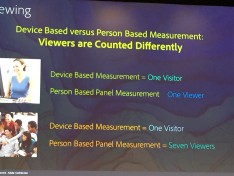
Coletti
The head of research at ESPN has said the industry needs to start to count online video views alongside the linear TV ratings, as people move across devices to an online world.
Dave Coletti, head of digital media research at the US sports network, said part of the problem was caused by there being a lack of agreement on what counts as a rating, and the industry’s reliance on hybrid “Frankenmetrics”, jamming online numbers together with TV ratings numbers.
“The challenge is that there’s no standardisation or syndication (of online video views) so our colleagues at the ad agencies don’t see that other than what we put forth,” he told a panel on the future of monetising media at the Adobe Summit today.
ADVERTISEMENT
“There’s a tremendous gap between what the media companies are seeing and what the advertisers and agencies see. It’s remarkable.
“TV, if you subscribe (to Nielsen data), you see every number that gets measured on a minute by minute basis, while digital you get at best once a month across some Frankenmonster which means nothing, no granularity of programming, and we’re sitting on 10 second by 10 second video measurements. That’s part of it to close that gap as well.”
His comments followed on from a presentation by the Canadian Broadcasting Company on research it carried out during its 2014 Sochi Winter Olympics coverage, which showed 2m hours worth of vieing difference between its streaming metrics and the TV method.
In Canada TV ratings are measured by a device carried by panel members which detects a unique inaudible sound for every channel, recording what they are seeing both in and out of the home.
 CBC embedded the same sounds into its digital streams, and after analysing the data found the TV method, which also asks the panel member to say how many people are watching, showed 13.2m hours of digital stream viewing, compared to 11.2m from its own analytics which counts just one viewer per device as it streams.
CBC embedded the same sounds into its digital streams, and after analysing the data found the TV method, which also asks the panel member to say how many people are watching, showed 13.2m hours of digital stream viewing, compared to 11.2m from its own analytics which counts just one viewer per device as it streams.
Analysis showed the biggest viewers were kids between three and 17 during school hours, when most of the big events took place.
“This issue of device based versus person based might be an issue we have to look at going forward,” said CBC researcher Craig Dismore.
He added: “All of this is challenging the way we look at cross platform measurement, we have to look at the data and challenge the data and try to tease out as much as we can from all of this. We’re not going to have single source all the time, but this was a big event and exceptional event.
“We’ve got to find a way of viewing this content in a different way and get the best understanding of content going forward.”
During the panel ESPN’s Coletti added: “At the moment, a lot of this gets back to the conversation we need to have with the industry about what counts for a rating, there needs to be ads loaded the same as it is with linear TV. So in our case all of our digital streaming
“We’re of the opinion that what we should be doing is having a measurement of content, measurement of advertising, and I think that helps our advertising partners as it allows them to track their advertising across screens. If someone’s watching an episode on demand that originally aired three years ago but the ad you’re seeing in the first break is new.”
Alex Hayes
Alex Hayes is a guest of Adobe at the Summit conference in Salt Lake City